
by blogediter | Apr 29, 2019 | Gas Logs
Q: Jason, Should I be concerned about using the Chimney Balloon to plug the flue if I have a gas fireplace and the pilot light is continuously on? The fireplace also has glass doors that seal about 90% of the fireplace. – CT
A: CT, A small pilot light will not burst the Chimney Balloon, but do keep in mind that when you seal your flue you are essentially eliminating the outside air source for your pilot light. So if the flame goes out the fuel smell will go into the house, and likewise all gases created by the pilot light burning are going into the home. It is our opinion that the gas source should be turned off along with the gas to the pilot so you have no backup of any kind into the home due to the energy saving tight seal of the Chimney Balloon. We realize this is an overly cautious statement to make, but our customers safety is foremost to us. – Jason
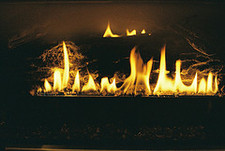
by blogediter | Apr 24, 2019 | Gas Logs
Q: Jason, I have a set of vent free gas logs in my fireplace. The fireplace also has a regular 18″ round chimney flue and a round metal flapper damper. If I understand correctly most vent free gas logs do not have a chimney since they are supposed to vent into the house directly to provide all the heat to the living area.
The damper on this ventless gas log fireplace chimney is worn out and lets in noise and cold air when the fireplace is not being used. Can I install a Chimney Balloon above the damper and close the damper and keep the Chimney Balloon in place even during the time I use this ventless gas log fireplace? – KK
A: Dear KK, We get a lot of questions about using a Chimney Balloon with gas log fireplaces. Especially about ventless gas log fireplaces that have chimneys. Most vent less (or vent free) gas log fireplaces do not have chimneys or flues in the first place. They are often designed to vent directly into the living area. This does allow them to give all of their heat to the living area, but it also allows them to give all of their fumes and moisture to the living area as well. For this reason I am not too keen on vent free gas logs.
To get to your question about the Chimney Balloon and if you can use it above your damper on this vent free gas log. You said your damper is leaking in cold air and noise from the outside and the damper is not in good shape. This means the leak goes both ways on your damper. Cold is coming in and heat certainly going out both during your fireplace use and when the fireplace is dormant. The Chimney Balloon is designed to shrivel and release when heat or fire is introduced to it. This release mechanism triggers at about 180 to 220 degrees. The Chimney Balloon does this because it is designed to plug the chimney flue, and in most cases it is not desirable to have a plugged chimney flue when you have a fire in your fireplace.
So if you light a fire in your ventless fireplace and the Chimney Balloon is installed above your damper (even with the damper closed) the damper itself will heat up and conduct heat through. As you said, the damper is also leaky since it allows cold air down, it will also allow heat up as well. That heat will come in contact with the Chimney Balloon. This will certainly trigger the release of the Chimney Balloon sooner or later (probably sooner). Then you will have a cooked Chimney Balloon. It is still worth it to have the Chimney Balloon in place in your fireplace when you are not using this vent free fireplace since it will eliminate the cold air and noise issue, but you cant leave it in place during use of your fireplace.
I have had many people ask: “what is safe to use above a ventless gas log to plug the flue?” Some people use safing insulation to plug the fireplace flue above a ventless gas log. I realize safing insulation is fire retardant, but safing insulation is not made for this specific purpose so this is a risky venture at best. – Jason
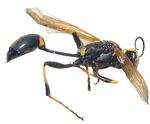
by blogediter | Mar 25, 2019 | Gas Logs, Chimney Problems
Q: Jason, I live in Dallas TX and I have a gas log fireplace. Every fall I get wasps coming in through the fireplace chimney and they make it through the damper into the house. Right now I am running the gas log 24/7 to keep the wasps out, but I know it is going to cost me in the utility bill at the end of this month. If I put in a Chimney Balloon will it seal tight enough so the bees cant get in the house? Can the bees sting through the Chimney Balloon? – TY
A: Dear TY, In the late fall (usually November) we get inundated with calls from fireplace and gas log owners that have wasps and bees coming down their fireplace chimney and right around their metal damper.
The Chimney Balloon seals wall to wall inside the chimney flue so it is a very good way to plug the chimney nice and tight so the wasps have no entry point through the flue. The Chimney Balloon material is made of a multilayer laminate so the wasps would never sting their way through it. But, It is always a good idea to get the Chimney Balloon installed before the wasps start their annual pilgrimage down your chimney. Once wasps start coming in they generally do it en-mass, so it is best to cut them off first.
Plugging the flue will allow you to turn off the gas log fireplace and save some of that gas you are burning up. It also won’t hurt for you to look around for other entry points that the wasps and bees may be coming in through like soffits or window jambs – Jason
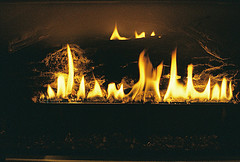
by blogediter | Mar 11, 2019 | Gas Logs
Jason – I converted my masonry fireplace with natural gas and installed an unvented gas log set. Can I install a Chimney Balloon above the damper, keeping the damper closed and ignite my gas logs without incurring any damage to the Chimney Balloon? The gas log set is rated at 39K but. Thanks, CB
Dear CB, If the temperature in the flue gets to about 200 degrees Fahrenheit it will trigger the release mechanism in the Chimney Balloon. Essentially the Chimney Balloon membrane melts and shrinks at the same time and the Chimney Balloon falls out of the Chimney. I’m betting that you will get heat conducting through your damper that will exceed 170 degrees within minutes with this vent free gas log turned on. Unfortunately, the metal from the damper will conduct the heat right through.
On the other hand, it will benefit you to use a Chimney Balloon above the damper when you are not using the fireplace. This is how it is normally used and it will keep your nice warm inside air inside where it belongs and not be floating up past a leaky damper.
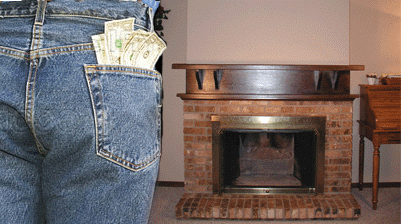
by blogediter | Dec 31, 2018 | Gas Logs
Fireplace Sucks amin
What would you do if the directions of your vented gas log fireplace said: “Step 4: Turn on the gas and light log set with a flaming $10 bill”. No matter what you tried, you couldn’t get the gas log to light unless you burned a $10 bill and put it to the logs to light it. I think you would be tempted to write the manufacturer about this issue, or talk to the store you bought it from, or maybe just not use it!
The inefficiency of a vented gas log fireplace
In a way, this is what it is like to use a vented gas log fireplace. You get little to no usable heat from the device, you consume fuel in it, its use/or non-use sucks heat from your home, but it sure makes a nice flickery flame. Is it worth it?
There are some key elements that are dead wrong with vented gas log kits. The primary issue is the damper use with these kits. Most state building codes say if a vented gas log is installed in a fireplace the metal damper has to be locked open or removed. The reason for this particular code is so that people don’t turn on their vented gas log and forget to open the damper and therefore asphyxiate the inhabitants of the home. The reality of this code is the homeowner has to live with a sizable hole in their homes energy envelope that is releasing energy 24/7.
Vented gas logs do not produce usable heat
The vented gas logs combustion process does little to produce usable heat to the living area. Much like a wood burning fireplace, the vented gas log wastes heat in many ways. The combustion process grabs already heated air from your home and burns the oxygen and combustible gasses in it. The heat that is created in this combustion quickly rises and grabs more heated inside air and tosses it up the chimney. You can restrict the amount of inside air that the fireplace has access to by installing glass doors, but this will also severely limit the amount of radiant heat that fireplace can cast forward into your living space. This radiant heat is the heat you feel on your skin in front of the fireplace and is the only usable heat that the fireplace will produce since the combustion heat is pouring out the top of the chimney. In the meantime, the home is drawing in cold outside air from other places (i.e. windows, light sockets, doors, etc) to replace the air that is escaping the home through the chimney. This is referred to as the “stack effect”.
How much money and heat is lost?
Most vented gas log operate at a consumption of .5 to 1 Therm per hour. In January of 2008 one Therm of Natural Gas cost me $1.57. So if you burn your vented gas log for 3 hours you wasted $4.71 worth of fossil fuels, and have no heat to show for it. With that same amount of natural gas you could have heated a 1200 sq ft home with a 95% efficient power vent furnace all day long.
Vented gas logs are good for ambiance
The flickery yellow flame that is produced by a vented gas log is a very realistic looking flame, but it is a low temperature flame and therefore tends to burn “dirty” and outputs soot and other pollutants. If you have a vented gas log fireplace or are considering having your wood fireplace fitted for one. Consider first the cost and environmental ramifications of using it.
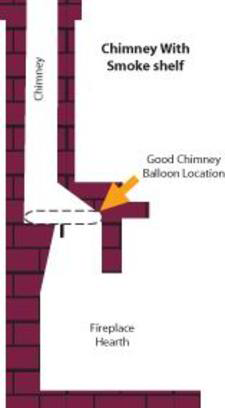
by blogediter | Dec 5, 2018 | Gas Logs
Chimney Balloon Diagram
Q: Jason, Recently getting my chimney swept, I was given an estimate of 1k to replace my disintegrated Smoke Shelf. The guy was nice and said that is why I sometimes may get smoke in the room (I do — but only initially and it goes away in less than 20 seconds). But, on his estimate, he noted that the chimney could be brought “into” code with said Smoke Shelf. Getting back to this Smoke Shelf, it is above the damper, and if it looks like the diagram shown, how on Earth could it be disintegrated? One thing the sweep did not mention was my crusty damper that actuates open funny- NG
A: NG, 20 seconds of smoke at the start is quite normal. I wouldn’t worry about that, but if it bothers you then glass doors will work to cut that smoke escape way back. Since the damper is actuating funny you would be looking at a Chimney Balloon ($50) or a replacement damper ($500 or so installed) to fix that issue. Repairing your smoke shelf will not help this issue much at all. If the condition of the inside of the smoke shelf of the chimney is in question, then the whole interior of the chimney would be in question, so you would really be looking more at a stainless chimney liner. But that would be up to a sweep that has a camera to inspect it well. Or you could just plug it and forget it, since traditional fireplaces are such a losing heat energy option anyway. Using them makes your energy bill go up – not down. – Jason





